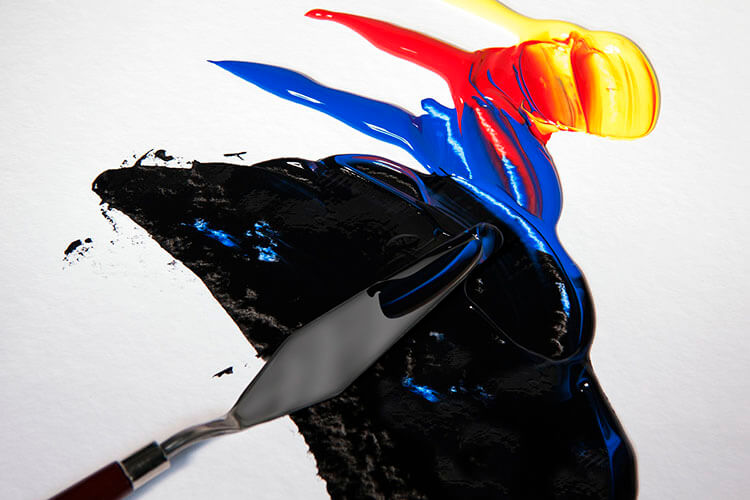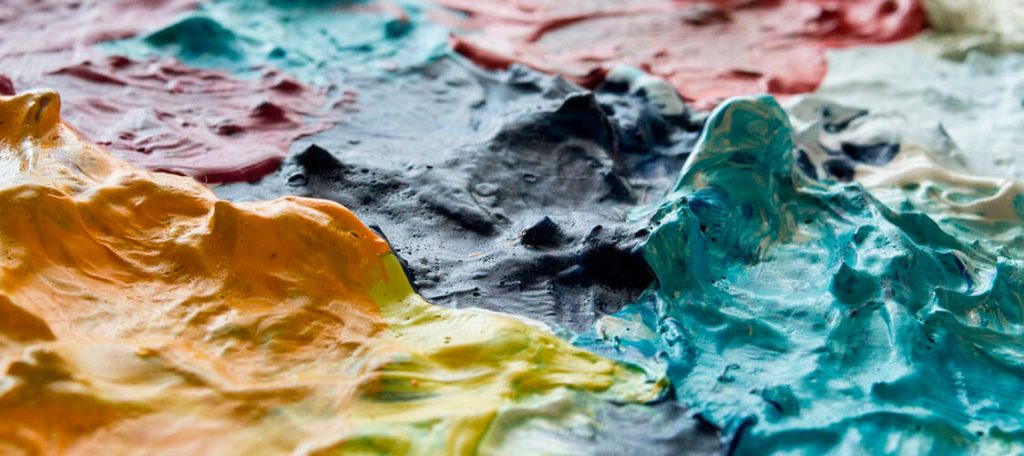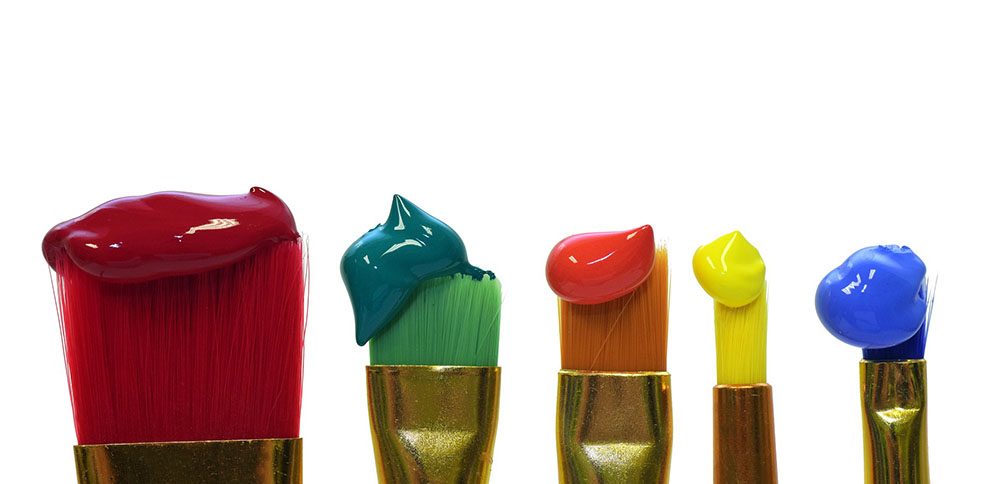Acrylic paint is a favorite medium for many artists due to its versatility, it can be thinned to create a wash or it can even replicate oil paints.
The key to successfully working with acrylic paints is knowing how to thin the paint and what to use, as this is what determines the finished outcome. So, let’s explore how to thin acrylic paint.
Properties Of Acrylic Paint And Ways To Thin It
How do you thin acrylic paint? There are several ways to thin acrylic paint including water and an acrylic binder/thinner/flow improver and other homemade acrylic flow improvers. The trick is knowing what to use to thin acrylic paint, to achieve different outcomes.
Before we delve in to more detail on the various techniques, it is useful to understand some properties of acrylic paint as that is why it reacts differently to the various mediums.
Properties of acrylic paint:
- Dries quickly
- No odors
- No toxic fumes
- Non flammable
- Good coverage
- Made up of color pigments and binding agents
Binders are great for providing a glossy, even appearance, they help the paint dry quickly and help to waterproof the acrylic paint when dry.
On occasion additives will be added to the paint to improve shelf life, however, these additives are toxic and therefore most quality acrylic paint brands will avoid this.

Why would you want to thin acrylic paint?
- Thinning your acrylic paint means it will last longer, you will get more work done using less paint which in turn saves you money.
- Thinning acrylics with water allows you to create colorful washes and watercolor effects in your paintings. They are arguably more long lasting than actual watercolor paints due to the stronger binders used.
- Thinning acrylic paints with mediums/binders/flow improvers will decrease the amount of paint you use, while keeping your color consistency, and slow your drying time slightly. So you have more time to work with the paint before it sets.
- Acrylic binder will create a strong paint that is glossy and you can varnish on top. By thinning your paints you can achieve different finished outcomes of your work.
Thinning Acrylic Paint With Water
Can acrylic paint be thinned with water? The short answer is yes water can be used to thin acrylic paint and this method has a desirable finished effect for many artists.
When adding water to acrylic paint the paint thins and this increases its spreadability. Water is the most popular method for thinning acrylic paint because it is the easiest and cheapest option. You do need to exercise caution however when watering down acrylic paint.
Most artists will tell you to use a ratio of 50% water to your paint. I think that it’s best when diluting your acrylic paint to use a separate jar or area of your palette and slowly add drops of water to your paint until the consistency is what you desire. Too much water will break down the binders in the acrylic paint and it won’t adhere to the surface.
When using an absorbent surface such as watercolor paper or canvas that hasn’t been primed with gesso, you can be less cautious about your water ratio. The water will soak into the material and color pigment will coat the surface to create a matte look similar to that of watercolors.
The best thing about this is that you can build layers of different shades, and use thicker consistency with less water, to have bolder color.
The following are some useful guidelines for using acrylics and water:
- Use small amounts of paint at a time, it dries quickly, so using small amounts will avoid wasted paint.
- When painting on a primed canvas or other non-absorbent surface use less water than you would otherwise, often it is said 30% water to 70% paint. Too much water in this case will mean the paint is broken down too thinly. The water has nowhere to go and the paint will peel and flake off your surface.
- Distilled water over and above tap water is better, as tap water can have particles that could disrupt the smoothness of your consistency. Failing using distilled water, try a water filter for your tap water.
Acrylic Thinning Medium and Acrylic Flow Improver
Acrylic thinning medium, flow improvers and binders all work in similar ways (occasionally they are used interchangeably). So, the guidelines and information points are also similar for each when using to thin acrylic paint.
- They do not affect the properties of the paint and just make it easier for the paint to flow across the surface. They thin the paint without reducing the color intensity or binding properties, so there is no risk of peeling as with water.
- Thinning medium will allow the paint to act as a primer so you can layer other colors on top. Flow improvers and acrylic binders will add a shine to your paint and strengthen it so you can layer, add gloss or a varnish on top.
- You don’t have to worry so much about ratios as you do with water, but it is best not to go over 50:50 as there is some risk of losing color intensity particularly with an acrylic binder.
- Follow instructions carefully and go for quality recognised brands over and above cheap products for best results, such as liquitex flow aid alternative.
- It is best to mix your paint and medium in a jar and stir until you have right consistency for what you need.
How To Rehydrate Acrylic Paint
Acrylic paints dry quickly and that can be both a curse and a blessing. If your acrylic paint has dried out you can try adding a little acrylic binder and water to try to revive the paint. If that doesn’t work then the paint has dried completely and it cannot be saved.
To avoid this try to keep your paint somewhat moist by spraying water over it while in use, only squeeze out the tubes what you need, and you can keep a damp piece of paper over the paint.

Homemade Acrylic Paint Thinner
It is possible to make your own acrylic paint thinner substitute. But you should exercise caution when thinning acrylic paint with alcohol and other substances due to the vapors being quite strong and potential of toxins.
How To Make Acrylic Paint Thinner
For the most basic thinner for acrylic paint, distilled water and isopropyl alcohol 99.9% are mixed at a ratio of 70:30. Some artists have been known to use an acrylic flow improver and retarder in their mix.
Once you have some experience of using acrylic thinner, binders, flow improvers and water you will know what works for you. If you want to experiment at that point and make your own mix, it means you’re going into that process knowing what you want out of it.
Final Tips
Depending on what I am trying to achieve I will pick carefully what I use to thin out acrylic paint. I often paint watercolor style paintings using acrylics so will opt to use water for this technique. If my paint is too thick for a very detailed piece of work I will use an acrylic flow aid to thin it out and make it easier to work with.
You need to use what works best for you and I recommend trying a range of things, starting first with water and an acrylic medium.
You don’t need to make your own acrylic paint thinner when you are first starting out, experiment with tried and tested techniques first to find out what you like.
Conclusion
I hope this article was of some use to all budding artists out there and the illusive question of how to thin acrylic paint, has now been answered. Now you can make an informed decision about how best to do this for yourself.


